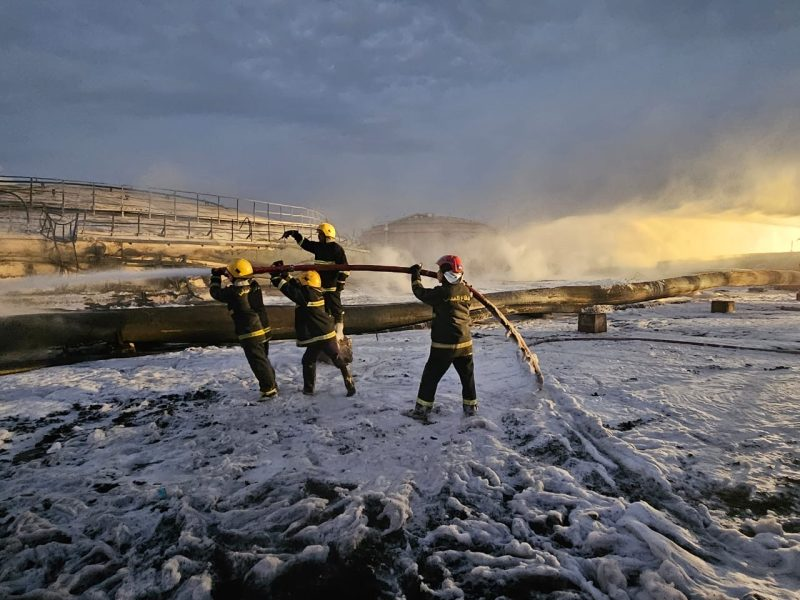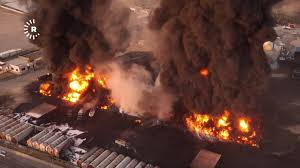Massive fire at oil field in Iraq brought under control after intense firefighting efforts, marking a significant achievement for emergency teams and local authorities. The blaze, which had posed a serious threat to workers, nearby communities, and regional oil supply, has now been successfully contained, reflecting the dedication and efficiency of all involved in the operation. This event highlights the ongoing challenges of oil field safety and the heroic efforts required to manage such emergencies.
Understanding the scale of the incident and the factors that contributed to controlling the fire is crucial for both industry professionals and the general public. It demonstrates how preparedness, swift action, and modern firefighting technology can mitigate potentially catastrophic outcomes.
Immediate Response and Containment Efforts
The first priority when a massive fire erupts at an oil field is ensuring the safety of personnel. In this case, Massive fire at oil field in Iraq brought under control thanks to rapid evacuation procedures and the deployment of specialized firefighting teams. Workers were safely guided to secure areas, and emergency protocols were activated immediately, minimizing casualties and potential injuries.
Firefighting crews utilized advanced techniques, including foam suppression systems and water cannons, to tackle the flames. The coordination between local authorities and on-site response units played a critical role in bringing the situation under control. The speed and efficiency of the initial response helped prevent the fire from spreading to neighboring storage tanks or facilities, which could have caused even more significant damage.
Technological Tools in Fire Management
Modern technology was a key factor in ensuring the massive fire at the oil field in Iraq brought under control. Drones, thermal imaging cameras, and real-time monitoring systems allowed firefighters to assess hotspots and direct resources efficiently.
The integration of advanced fire suppression systems, including foam and chemical retardants, helped reduce the intensity of the blaze. Remote-controlled equipment enabled crews to operate safely from a distance, minimizing exposure to extreme heat and hazardous gases. This technological edge not only saved lives but also limited the overall damage to the oil infrastructure, ensuring a faster return to normal operations.
Collaboration Between Teams and Authorities
Bringing a massive fire at an oil field under control requires seamless collaboration. Local emergency services, oil company teams, and regional authorities worked tirelessly to coordinate efforts, share information, and implement effective containment strategies.
Regular drills and preparedness training played a crucial role. Teams knew exactly how to respond to high-risk scenarios, enabling them to act quickly and decisively. The collaborative effort exemplifies how teamwork, clear communication, and prior planning are indispensable when handling large-scale industrial emergencies.
Environmental Impact and Safety Measures
While the immediate focus was on extinguishing the flames, attention to environmental protection was also critical. Massive fire at oil field in Iraq brought under control with measures to reduce air pollution, prevent oil spillage, and minimize harm to surrounding wildlife. Specialized containment booms and barriers were deployed to stop oil from entering nearby soil and water sources.
Safety measures extended beyond the fire itself. Workers and emergency teams were equipped with protective gear to handle toxic fumes, and air quality monitoring was continuously conducted to ensure the safety of surrounding communities. This proactive approach helped manage both immediate and long-term environmental consequences.
Economic and Regional Significance
Oil fields are vital to Iraq’s economy and regional energy supply. The rapid containment of this fire prevented significant disruption to oil production and export. Massive fire at oil field in Iraq brought under control, allowing operators to resume preliminary operations safely and maintain stability in supply chains.
The incident highlights the resilience of Iraq’s energy sector and the effectiveness of emergency preparedness. Quick containment ensured minimal economic loss and reinforced investor confidence in the safety and reliability of the country’s oil infrastructure.

Human Effort Behind the Victory
The containment of a massive fire at an oil field is not just a technical achievement; it is also a testament to human courage and dedication. Firefighters worked under extreme conditions, facing intense heat and thick smoke, demonstrating exceptional bravery.
Their commitment, along with strategic planning and teamwork, ensured that the fire did not escalate into a larger disaster. The success of this operation underscores the importance of training, experience, and dedication in crisis management. Communities and workers alike can feel reassured by the professionalism and expertise demonstrated during the emergency.
Lessons Learned and Future Preparedness
Every large-scale fire provides valuable lessons for future safety measures. Following this incident, experts are reviewing protocols to enhance fire detection systems, improve evacuation procedures, and upgrade fire suppression technology.
The successful containment of this fire reinforces the importance of proactive risk management. Regular maintenance, emergency drills, and investment in cutting-edge firefighting tools will continue to play a critical role in preventing future incidents. By learning from this event, Iraq’s oil sector strengthens its resilience against potential hazards.
Community and Worker Reassurance
After such emergencies, ensuring the confidence of workers and local communities is vital. Massive fire at oil field in Iraq brought under control provides reassurance that authorities and emergency teams can handle high-risk situations effectively.
Support services, including counseling and safety workshops, have been made available to affected workers, emphasizing the human-centric approach to crisis management. Communities near the oil field are being engaged with clear communication to reduce panic and misinformation.
Global Observations and Industry Standards
The incident has drawn attention from the global energy sector, emphasizing the critical need for robust safety standards in oil production. Lessons from Iraq’s response can inform policies and emergency protocols worldwide.
By successfully containing the fire, Iraq demonstrates that with proper planning, modern technology, and coordinated human effort, even large-scale industrial disasters can be managed effectively. This sets a positive precedent for other oil-producing regions striving to enhance operational safety and environmental protection.
Moving Forward: Recovery and Reinforcement
With the fire contained, focus shifts to recovery and reinforcing infrastructure. Damage assessment teams are evaluating affected facilities to ensure operational safety and integrity. Repairs and safety upgrades are being prioritized to prevent future incidents.
Investment in safety training, technology, and environmental protection remains a top priority. The swift and successful response has set a benchmark for how emergencies can be handled efficiently while protecting human life, the environment, and economic interests.
As Iraq continues to strengthen its oil field safety measures, the containment of this massive fire stands as a reminder of what coordinated effort, preparation, and resilience can achieve in the face of extreme challenges.
Do follow us: Instagram
Read More: Diriyah Gate Sector: 7 Reasons It’s Culturally Iconic



